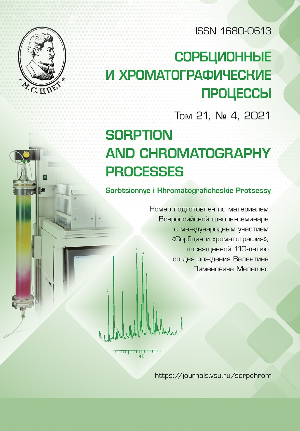A comparative analysis of reverse osmosis membranes by laser desorption/ionisation
Abstract
The market share for reverse osmosis (RO) has been growing over the past few years. The popularity of the RO can be explained by its simplicity and a relatively low energy intensity. As a result, this technology is being used by more than half desalination units installed all over the world. Commercial RO membranes typically consist of an active layer of an aromatic polyamide with a microporous polysulphone support layer. However, such membranes are easily exposed to biological fouling, which limits their use in water purification. It is also important to control their support layer to prevent its degradation. The aim of this work was to conduct a comparative analysis of reverse osmosis membranes by laser desorption/ionisation (LDI), which made it possible to reveal similarities and differences between grafted functional groups and compare the stability of the polymer layers that make up the membrane. Mass spectrometry is a method of soft ionisation with minimum analyte fragmentation. The main features of the LDI involve its simplicity, possibility of fast analysis, high productivity, low volumes of analytes, and no or low fragmentation. Four samples of reverse osmosis membranes (Vladimir, AO RM Nanotek) and one sample representing their foreign analogue were studied in this work. The mass spectra of the studied materials were recorded on a Bruker Ultraflex device equipped with a nitrogen laser with a wavelength of 337 nm and the energy of 110 μJ. The spectra were recorded in the mode of registering positive ions within the range of m/z 20-2.000 Da. The paper shows the possibility of identifying peaks characteristic of the polysulphone and polyamide layers in polymeric materials, identifies the functional groups grafted onto the polyamide layer of RO membranes, identifies clusters of inorganic salts on the surface of RO membranes formed during the operation, and shows their similarities and differences in the studied membranes. Therefore, the research showed the possibility of performing a rapid analysis of RO membranes by the method of LDI mass spectrometry. This method makes it possible to determine the components of the support and separation layers of RO membranes and the clusters of inorganic salts formed on the surface of polymeric materials.
Downloads
References
Honig R.E., Woolston J.R., Applied Physics Letters, 1963, Vol. 2, No 2, pp. 138-139. doi:10.1063/1.1753812.
Zakett D., Schoen A.E., Cooks R.G., Hemberger P.H., Journal of the American Chemical Society, 1981, Vol. 103, No 5, pp. 1295-1297. doi:10.1021/ja00395a086.
Arakawa R., Kawasaki H., Analytical Sciences, 2010, Vol. 26, No 12, pp. 1229-1240. doi:10.2116/analsci.26.1229.
Bergman N., Shevchenko D., Analytical and Bioanalytical Chemistry, 2014, Vol. 406, No 1, pp. 49-61. doi:10.1007/s00216-013-7471-3.
Mandal A., Singha M., Addy P.S., Basak A., Mass Spectrometry Reviews, 2019, Vol. 38, No 1, pp. 3-21. doi:10.1002/mas.21545.
El-Aneed A., Cohen A., Banoub J.M., Applied Spectroscopy Reviews, 2009, Vol. 44, No 3, pp. 210-230. doi:10.1080/05704920902717872.
Krutchinsky A.N., Chait B. J., Am. Soc. Mass Spectrom., 2002, Vol. 13, No 2, pp. 129-134. doi:10.1016/S1044-0305(01)00336-1.
Dattelbaum A.M., Iyer S., Expert Rev. Proteomics, 2006, Vol. 3, No 1, pp. 153-161. doi:10.1586/14789450.3.1.153.
Song K., Cheng Q., Applied Spectrosco-py Reviews, 2019, Vol. 55, No 13, pp. 1-23. doi:10.1080/05704928.2019.1570519.
Tanaka K., Waki H., Ido Y., Akita S. et al., Rapid Communications in Mass Spec-trometry, 1988, Vol. 2, No 8, pp. 151-153. doi:10.1002/rcm.1290020802.
Kang M.J., Seong Y., Kim M.J., Kim M.S., et al., Applied Chemistry for Engineer-ing, 2017, Vol. 28, No 3, pp. 263-271. doi:10.14478/ace.2017.1019.
Pyckij I.S., Kuznecova E.S., Burjak A.K., Sorbtsionnye i khromatograficheskie protsessy, 2021, Vol. 21, No 1, pp. 69-76. doi: https://doi.org/10.17308/sorpchrom.2021.21/3221
López-García M., García M.S.D., Vi-lariño J.M.L., Rodríguez M.V.G., Food Chemistry, 2016, Vol. 199, pp. 597-604. doi:10.1016/j.foodchem.2015.12.016.
Kosyakov D.S., Anikeenko E.A., Ul’yanovskii N.V., Khoroshev O.Y. et al., Analytical and Bioanalytical Chemistry, 2018, Vol. 410, No 28, pp. 7429-7439. doi:10.1007/s00216-018-1353-7.
Spring A.M., Maeda D., Ozawa M., Odoi K. et al., Polymer, 2015, Vol. 56, pp. 189-198. doi:10.1016/j.polymer.2014.11.043.
Gies A.P., Ellison S.T., Stow S.M., Hercules D.M., Analytica Chimica Acta, 2014, Vol. 808, pp. 124-143. doi:10.1016/j.aca.2013.09.007.
Nishimori K., Ouchi M., Sawamoto M., Macromolecular rapid communications, 2016, Vol. 37, No 17, pp. 1414-1420. doi:10.1002/marc.201600251.
Yol A.M., Dabney D.E., Wang S.-F., Laurent B.A. et al., ,J. Am. Soc. Mass Spec-trom., 2013, Vol. 24, No 1, pp. 74-82. doi:10.1007/s13361-012-0497-5.
Giwa A., Akther N., Dufour V., Ha-san S.W., RSC Advances, 2016, Vol. 6, No 10, pp. 8134-8163. doi:10.1039/c5ra17221g.
Shenvi S.S., Isloor A.M., Ismail A.F., Desalination, 2015, Vol. 368, pp. 10-26. doi:10.1016/j.desal.2014.12.042.
Kang G.D., Gao C.J., Chen W.D., Jie X.M. et al., Journal of Membrane Science, 2007, Vol. 300, No 1-2, pp. 165-171. doi:10.1016/j.memsci.2007.05.025.
GOST 10896-78: Ionity. Podgotovka k ispytaniju. – Vveden 1980-01-01. M., Iz-datel'stvo standartov, 1980.
Ellison S.T., Gies A.P., Hercules D.M., Morgan S.L., Macromolecules, 2009, Vol. 42, No 8, pp. 3005-3013. doi:10.1021/ma900161y.
Lau W.J., Ismail A.F., Misdan N., Kassim M.A., Desalination, 2012, Vol. 287, pp. 190-199. doi:10.1016/j.desal.2011.04.004.
Liu M., Yu C., Wu Y., Lü Z. et al., Chemical Engineering Research and Design, 2019, Vol. 141, pp. 402-412. doi:10.1016/j.cherd.2018.11.009.







